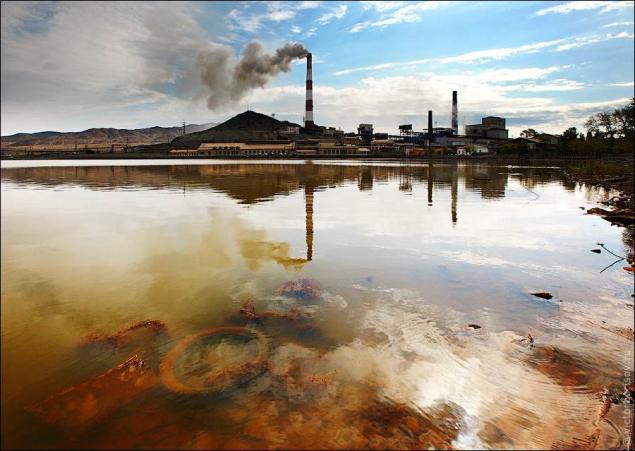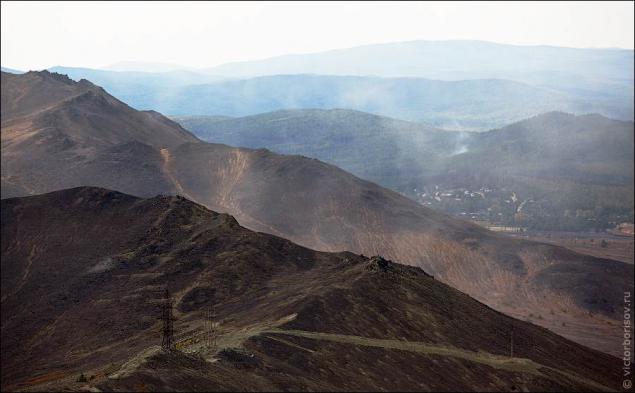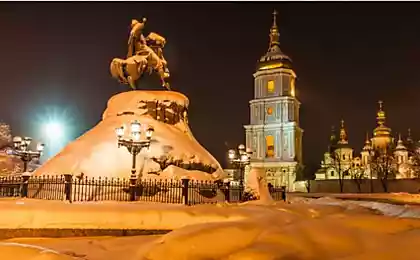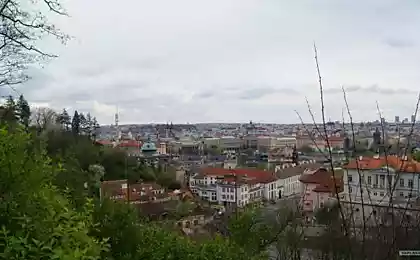748
Karabash - the dirtiest city in the world
Karabash - the city in the Chelyabinsk region with a population of 15 000 people. Karabash arose in 1822 after the discovery of gold placers on the site of an ancient Tatar settlement. Name Karabash Tatar means "black head". In the early 20th century in Karabash began to mine copper. After several decades of production of copper ore and copper smelting, the city became an ecological disaster area. Initially, the plant did not have sewage treatment plants - in Soviet times about ecology, nobody thought.
For 100 years, he managed to combine to burn slag and cover a huge area around it. For the year of plant throws into the atmosphere of more than 180 tons of gases which falls as acid rain on the surrounding area.
In the 19th century in the valley were discovered deposits of copper ore, and in 1837 built the first copper smelter, which lasted five years. Old copper plant was the second plant mednodelatelnym in the valley and was built in 1907. This plant has worked for three years.
In 1910, in a valley near the mountains Karabash launched a new smelter, which still works. Five years after the opening of the plant was producing a third of all Russian copper.
20 Photo © victorprofessor

Mountain, located on the border of the city, completely lost forest cover. On Bald Mountain in Karabash of stones was laid inscription "Save and Protect". Above the inscription is an iron cross 25 meters tall pieces of sill.

The city is very dusty and hard to breathe. In recent years, the problems of emissions of copper smelting production added problem of the erosion of the city dump flood waters of the river Sak-Elga

And here is the culprit of environmental catastrophe - copper smelter. In the river Sak-Elga iron levels 500 times higher than the permissible norm. At a distance of 100 meters from the coast nothing grows.

View of the city from the top of Bald Mountain.

In recent years, carried out a large-scale reconstruction of the smelter, there is a construction of treatment facilities. The ecological situation in the city has improved, for example, you can see the new trees growing on a hillside. But in general, the normal state of affairs can not be named.

In the production of copper from copper ore generates large quantities of pollutants, mainly gas, such as for example derivatives of lead, sulfur, arsenic and actually copper.

All these gases are released during the period of the plants virtually unchecked emissions and they are not cleaned. As a result, the total weight of emissions for the full period of the plants was more than 14 million tons.

...

After processing thousands of tons of rock are cuttings. His dump near the plant. As a result, here are these piles.

Here's what a normal forest.

The ore contains less than 1% copper. Thus, to obtain one ton of copper is necessary to recycle 100 tons of rock.

The greatest danger to the ecological conditions are acid rain.

Copper contained in the rock in the form of sulfides, obtained on firing sulfur dioxide SO2. In the atmosphere, it forms sulfuric acid H2SO4, which falls as rain in the surrounding area.

Waste heaps of processed rock in the height of over 50 meters.

At constant acid rain all vegetation dies. Once the vegetation dies, then rain and wind very quickly washed off the land. Mountains turn into rock.

The main part of the city looks like a village. The inhabitants of the set of genetic and acquired diseases: cancers, eczema, kidney stones, fetal development defects, dementia, cerebral palsy.

Pay attention to the bald head in the forests. Birch stood acid rain, but all the vegetation beneath them died. It looks awful.

At the end of 1989, in connection with the crisis situation in urban ecology (environment deteriorates to such an extent that the city is dying vegetation) old metallurgical production was halted. A fifth of the population of the city was left without work. The social situation of the city is undergoing at this time of deep crisis. The city's population has decreased to 15 thousand. Man.

In 1998, the copper-smelting production was started again because of the worsening socio-economic situation.
So here and live. Better, of course, 20 years ago, but still not good.

Source:
For 100 years, he managed to combine to burn slag and cover a huge area around it. For the year of plant throws into the atmosphere of more than 180 tons of gases which falls as acid rain on the surrounding area.
In the 19th century in the valley were discovered deposits of copper ore, and in 1837 built the first copper smelter, which lasted five years. Old copper plant was the second plant mednodelatelnym in the valley and was built in 1907. This plant has worked for three years.
In 1910, in a valley near the mountains Karabash launched a new smelter, which still works. Five years after the opening of the plant was producing a third of all Russian copper.
20 Photo © victorprofessor

Mountain, located on the border of the city, completely lost forest cover. On Bald Mountain in Karabash of stones was laid inscription "Save and Protect". Above the inscription is an iron cross 25 meters tall pieces of sill.

The city is very dusty and hard to breathe. In recent years, the problems of emissions of copper smelting production added problem of the erosion of the city dump flood waters of the river Sak-Elga

And here is the culprit of environmental catastrophe - copper smelter. In the river Sak-Elga iron levels 500 times higher than the permissible norm. At a distance of 100 meters from the coast nothing grows.

View of the city from the top of Bald Mountain.

In recent years, carried out a large-scale reconstruction of the smelter, there is a construction of treatment facilities. The ecological situation in the city has improved, for example, you can see the new trees growing on a hillside. But in general, the normal state of affairs can not be named.

In the production of copper from copper ore generates large quantities of pollutants, mainly gas, such as for example derivatives of lead, sulfur, arsenic and actually copper.

All these gases are released during the period of the plants virtually unchecked emissions and they are not cleaned. As a result, the total weight of emissions for the full period of the plants was more than 14 million tons.

...

After processing thousands of tons of rock are cuttings. His dump near the plant. As a result, here are these piles.

Here's what a normal forest.

The ore contains less than 1% copper. Thus, to obtain one ton of copper is necessary to recycle 100 tons of rock.

The greatest danger to the ecological conditions are acid rain.

Copper contained in the rock in the form of sulfides, obtained on firing sulfur dioxide SO2. In the atmosphere, it forms sulfuric acid H2SO4, which falls as rain in the surrounding area.

Waste heaps of processed rock in the height of over 50 meters.

At constant acid rain all vegetation dies. Once the vegetation dies, then rain and wind very quickly washed off the land. Mountains turn into rock.

The main part of the city looks like a village. The inhabitants of the set of genetic and acquired diseases: cancers, eczema, kidney stones, fetal development defects, dementia, cerebral palsy.

Pay attention to the bald head in the forests. Birch stood acid rain, but all the vegetation beneath them died. It looks awful.

At the end of 1989, in connection with the crisis situation in urban ecology (environment deteriorates to such an extent that the city is dying vegetation) old metallurgical production was halted. A fifth of the population of the city was left without work. The social situation of the city is undergoing at this time of deep crisis. The city's population has decreased to 15 thousand. Man.

In 1998, the copper-smelting production was started again because of the worsening socio-economic situation.
So here and live. Better, of course, 20 years ago, but still not good.

Source:























